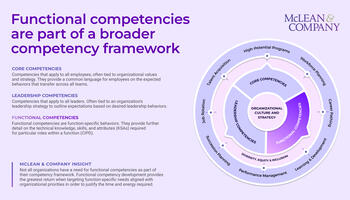- Many organizations fail to identify the underlying need for functional competencies, risking significant resource investment with minimal return on investment.
- On average, 59% of HR departments believe competency frameworks are highly important to achieving organizational and HR goals, while only 18% report their organization’s competency framework is highly effective (McLean & Company HR Organizational Alignment Diagnostic Survey Database 2020-2023; N=34).
- Developing functional competencies without a need in mind risks over-complicating an existing competency framework. The development of functional competencies is a time-intensive project and requires active engagement from functional incumbents to assist in the development and integration of functional competencies into relevant HR program areas (e.g. performance management, learning & development).
Need Extra Help?
Speak With An Analyst.
- Get on-demand project support
- Get advice, coaching, and insight at key project milestones
- Go through a Guided Implementation to help you get through your project

Our Advice
Critical Insight
Not all organizations have a need for functional competencies as part of their competency framework. Functional competency development provides the greatest return when targeting function-specific needs aligned with organizational priorities in order to justify the time and energy required.
Impact and Result
- Be intentional when developing functional competencies by identifying the underlying need and engaging functional leaders from the beginning to support buy-in.
- Prioritize functions with the greatest need and capacity to support competency development and identify alternative solutions, where applicable.

 Develop a Talent Management Framework
Develop a Talent Management Framework
 Develop Core and Leadership Competencies
Develop Core and Leadership Competencies
 Create Functional Competencies
Create Functional Competencies
 Strategically Develop a 360 Feedback Process
Strategically Develop a 360 Feedback Process
 Develop a Leadership Strategy to Drive Organizational Results
Develop a Leadership Strategy to Drive Organizational Results